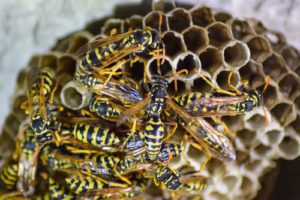 Wasps are some of the most common pests in Utah, especially during the summer months. Sometimes they hover around your picnic while you’re trying to enjoy a day outside. However, they can also be dangerous if they feel threatened and swarm.
Wasps are some of the most common pests in Utah, especially during the summer months. Sometimes they hover around your picnic while you’re trying to enjoy a day outside. However, they can also be dangerous if they feel threatened and swarm.
Utah is home to several species of wasps, including paper wasps, mud-daubers, and yellow jackets. Wasps generally eat insects and spiders, which can make them convenient in a garden when you’d like to keep other pests away. However, sometimes they cause more problems than the garden pests that they eat.
What they look like
Different species of wasps come in different sizes and colors. However, all wasps are identifiable by their three distinctly separated body segments (head, thorax, and abdomen) and two pairs of wings. Wasps might be dark-colored, and some species in Utah even have bluish wings. However, the most common wasps in Utah are colored with black and yellow banding and patterns.
Most of the time, though, the sign of a wasp infestation in your yard or around your house is evident by the distinctive nest. Below are some of the more common wasp nests you might encounter:
- Mud dauber nests look just as they sound: patches of mud with tubed entrances throughout the nest.
- Paper wasps build their nests out of a combination of wood and saliva. Often, their nests are an interesting-looking honeycombed pattern.
- Bald Faced Hornets are also considered wasps, and their nests are usually beautiful swirled paper as big as a baseball. Hornets are very aggressive, and therefore, these nests should be treated with the utmost caution.
Where you might find them
Paper wasps build a new colony every year, and so you might see them crop up and disappear throughout your yard often. Their nests can be built in any area that provides protection from the elements. Often, they’re found in rafters of a house or shed. They can also be found in the cavities of rocks, in trees, or in the ground, which is more common for mud daubers. Any kind of wasp might also build their home in a tree.
Are wasps dangerous?
About 90% of stings are actually caused by wasps, even though people often mistakenly attribute them to bees. Unlike bees, wasps are able to sting repeatedly without dying thanks to their smooth stingers (bees’ stingers are barbed.) Wasps, in general, are more aggressive than bees, but they still won’t usually sting unless they feel that their nest is threatened. Stings are painful, but not usually dangerous unless (1) someone is stung repeatedly by many wasps, or (2) they are allergic to the venom in wasp stings, causing them to go into anaphylactic shock.
How to get rid of wasps
Any wasp nest should be approached with caution since even the mildest species will become aggressive if they believe the nest is threatened.
In order to rid your home of wasp nests, our pest control experts will first need to inspect the nest in order to determine which species is present. Then, taking safety precautions, we’ll use an appropriate pesticide spray to disarm the nest. Afterward, it’s very important to survey the area and take precautions to avoid re-infestation. This might be a matter of slight modifications in the structures and area in order to discourage wasps. It can also include pheromone traps around the perimeter of your yard and smart tidiness habits that will keep wasps from being attracted to your yard (for example, sugar from exposed drinks and trash cans can be very attractive to certain species.)
If you’re ready to get rid of wasps, please Contact Us Today. Our experts are here to help!


